
The spore print is the powdery deposit obtained by allowing spores of a fungal fruit body to fall onto a surface underneath. It is an important diagnostic character in most handbooks for identifying mushrooms. It shows the colour of the mushroom spores if viewed en masse.

The Russulaceae are a diverse family of fungi in the order Russulales, with roughly 1,900 known species and a worldwide distribution. They comprise the brittlegills and the milk-caps, well-known mushroom-forming fungi that include some edible species. These gilled mushrooms are characterised by the brittle flesh of their fruitbodies.
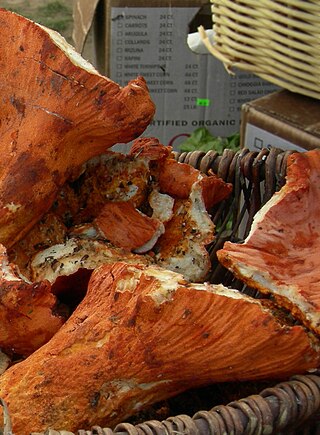
Hypomyces lactifluorum, the lobster mushroom, contrary to its common name, is neither a mushroom nor a crustacean, but rather a parasitic ascomycete fungus that grows on certain species of mushrooms, turning them a reddish orange color that resembles the outer shell of a cooked lobster. H. lactifluorum specifically attacks members of the genera Lactarius and Lactifluus (milk-caps), and Russula (brittlegills), such as Russula brevipes and Lactifluus piperatus in North America. At maturity, H. lactifluorum thoroughly covers its host, rendering it unidentifiable. Lobster mushrooms are widely eaten and enjoyed freshly foraged and cooked. They are commercially marketed and sometimes found in grocery stores; they have been made available at markets in Oregon. They have a seafood-like flavor and a firm, dense texture.
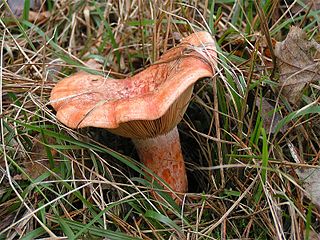
Lactarius deliciosus, commonly known as the delicious milk cap, saffron milk cap and red pine mushroom, is one of the best known members of the large milk-cap genus Lactarius in the order Russulales. It is native to Europe, but has been accidentally introduced to other countries along with pine trees, with which the fungus is symbiotic.

Lactarius torminosus, commonly known as the woolly milkcap or the bearded milkcap, is a large agaric fungus. A common and widely distributed species, it is found in North Africa, northern Asia, Europe, and North America. It was first described scientifically by Jacob Christian Schäffer in 1774 as an Agaricus, and later transferred to the genus Lactarius in 1821 by Samuel Frederick Gray. A variety, L. torminosus var. nordmanensis, is known from the United States, Canada, and Switzerland. L. torminosus officially became the type species of Lactarius in 2011 after molecular studies prompted the taxonomic reshuffling of species between several Russulaceae genera.
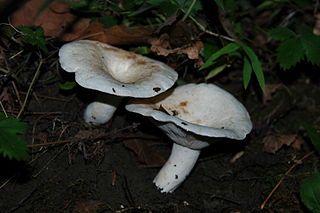
Lactifluus piperatus, commonly known as the blancaccio, is a semi-edible basidiomycete fungus of the genus Lactifluus. Despite being edible, it is not recommended by some because of its poor taste, though can be used as seasoning when dried. The fruiting body is a creamy-white mushroom which is funnel-shaped when mature, with exceptionally crowded gills. It bleeds a whitish peppery-tasting milk when cut. Widely distributed across Europe and eastern North America, Lactifluus piperatus has been accidentally introduced to Australia. Mycorrhizal, it forms a symbiotic relationship with various species of deciduous tree, including beech, and hazel, and fruiting bodies are found on the forest floor in deciduous woodland.

Lactifluus volemus, formerly known as Lactarius volemus, and commonly known as the weeping milk cap or bradley, is a species of fungus in the family Russulaceae. It is widely distributed in the northern hemisphere, in temperate regions of Europe, North America and Asia as well as some subtropical and tropical regions of Central America and Asia. A mycorrhizal fungus, its fruit bodies grow on the ground at the base of various species of trees from summer to autumn, either individually or in groups. It is valued as an edible mushroom, and is sold in markets in Asia. Several other Lactifluus mushrooms resemble L. volemus, such as the closely related edible species L. corrugis, but these can be distinguished by differences in distribution, visible morphology, and microscopic characteristics. L. volemus produces a white spore print and has roughly spherical spores about 7–8 micrometres in diameter.

Lactarius vietus is a species of fungus in the family Russulaceae, first described by Elias Magnus Fries. It produces moderately sized and brittle mushrooms, which grow on the forest floor or on rotting wood. The flattened-convex cap can vary in shape, sometimes forming the shape of a wide funnel. It is typically grey, but the colour varies. The species has crowded, light-coloured gills, which produce white milk. The spore print is typically whitish, but also varies considerably. The mushrooms typically have a strong, acrid taste and have been described as inedible, but other authors have described them as consumable after boiling. L. vietus feeds by forming an ectomycorrhizal relationship with surrounding trees, and it favours birch. It grows in autumn months and is fairly common in Europe, North America and eastern Asia.
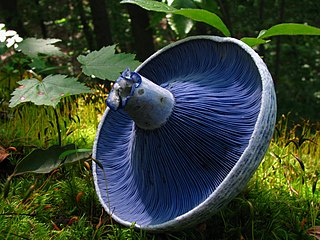
Lactarius indigo, commonly known as the indigo milk cap, indigo milky, the indigo lactarius, or the blue milk mushroom, is a species of agaric fungus in the family Russulaceae. It is a widely distributed species, growing naturally in eastern North America, East Asia, and Central America; it has also been reported in southern France. L. indigo grows on the ground in both deciduous and coniferous forests, where it forms mycorrhizal associations with a broad range of trees. The fruit body color ranges from dark blue in fresh specimens to pale blue-gray in older ones. The milk, or latex, that oozes when the mushroom tissue is cut or broken — a feature common to all members of the genus Lactarius — is also indigo blue, but slowly turns green upon exposure to air. The cap has a diameter of 5–15 cm (2–6 in), and the stem is 2–8 cm (0.8–3 in) tall and 1–2.5 cm (0.4–1.0 in) thick. It is an edible mushroom, and is sold in rural markets in China, Guatemala, and Mexico. In Honduras, the mushroom is called a chora, and is generally eaten with egg; generally as a side dish for a bigger meal.

Lactarius alnicola, commonly known as the golden milkcap, is a species of fungus in the family Russulaceae. The fruit bodies produced by the fungus are characterized by a sticky, vanilla-colored cap up to 20 cm (7.9 in) wide with a mixture of yellow tones arranged in faint concentric bands. The stem is up to 5 cm (2.0 in) long and has yellow-brown spots. When it is cut or injured, the mushroom oozes a white latex, which has an intensely peppery taste. The acrid taste of the fruit bodies renders them unpalatable. The fungus is found in the western United States and Mexico, where it grows in mycorrhizal associations with various coniferous trees species, such as spruce, pine and fir, and deciduous species such as oak and alder. It has also been collected in India. Two varieties have been named: var. pitkinensis, known from Colorado, and var. pungens, from Michigan.

Lactarius affinis, commonly known as the kindred milk cap, is a species of milk-cap mushroom in the family Russulaceae. It is found northeastern North America, where it fruits in the summer and fall, and is common in the Great Lakes region. Its fruit bodies have medium to large, slimy dull yellow or brownish caps. Although not considered poisonous, it is unpalatable because of its highly acrid taste.

Lactarius fumosus, commonly known as the smoky milkcap, is a species of fungus in the family Russulaceae.

Lactifluus deceptivus, commonly known as the deceiving milkcap, is a common species of fungus in the family Russulaceae. It is found throughout eastern North America on the ground in coniferous forests near hemlock or deciduous forests near oak, and in oak-dominated forests of Costa Rica. It produces large mushrooms with funnel-shaped caps reaching up to 25 cm (9.8 in) in diameter, on top of hard white stems that may reach 4–10 cm (1.6–3.9 in) long and up to 3 cm (1.2 in) thick. The gills are closely spaced together and yellowish-cream in color. When young, the cap is white in all parts, but the depressed center becomes dull brownish in age and breaks up into scales. The edge of the cap has a roll of cottony tissue that collapses as the cap expands. The surface of the stem—especially near the base—has a velvety texture. The mushroom "bleeds" a milky white acrid latex when it is cut or injured. Similar milk-cap species with which L. deceptivus might be confused include Lactifluus piperatus, L. pseudodeceptivus, L. caeruleitinctus, L. subvellereus, Lactarius arcuatus and Lactarius parvulus.

Lactarius rufulus, commonly known as the rufous candy cap, is a species of fungus in the family Russulaceae. The fruit bodies have fleshy brownish-red caps up to 10 cm (3.9 in) wide, and closely spaced pinkish-yellow gills. The stem is up to 12 cm (4.7 in) long and 3 cm (1.2 in) thick and colored similarly to the cap. The species, known only from California, Arizona, and Mexico, grows on the ground in leaf litter near oak trees. The fruit bodies resembles those of L. rufus, but L. rufulus tends to grow in clusters at a common base, rather than solitarily or in groups. A distinguishing microscopic characteristic is the near absence of large, spherical cells called sphaerocysts that are otherwise common in Lactarius species. Lactarius rufulus mushrooms are edible, and have an odor resembling maple syrup. They have been used to flavor confections and desserts.

Lactifluus hygrophoroides is a member of the milk-cap genus Lactifluus in the order Russulales. It was first described scientifically by Miles Joseph Berkeley and Moses Ashley Curtis in 1859 as a species of Lactarius, and was historically known by this name until the systematics of milk-cap species were recently revised. It is a choice edible, although some report its taste to be mild.

Lactifluus is one of three genera of mushroom-forming fungi containing species commonly named "milk-caps", the others being Lactarius and Multifurca. It has been separated from Lactarius based on molecular phylogenetic evidence but is very similar to that genus. There are roughly 150 known Lactifluus species, which have a mainly tropical distribution but are also found in the north temperate zone and Australasia. Some of them are edible mushrooms.

Lactifluus clarkeae, formerly known as Lactarius clarkeae, is a species of mushroom-forming fungus in the family Russulaceae. It is found in Australia and New Zealand in mycorrhizal association with species of Nothofagus and the family Myrtaceae.
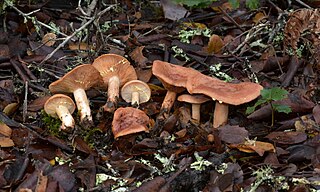
Lactarius xanthogalactus, commonly known as the yellow-staining milkcap is a poisonous species of fungus in the family Russulaceae. The species is found on the west coast of the United States and grows in the ground in association with hardwood and conifer trees. There are several other Lactarius species that bear resemblance to L. xanthogalactus, but most can be distinguished by differences in staining reactions, macroscopic characteristics, or habitat.


















